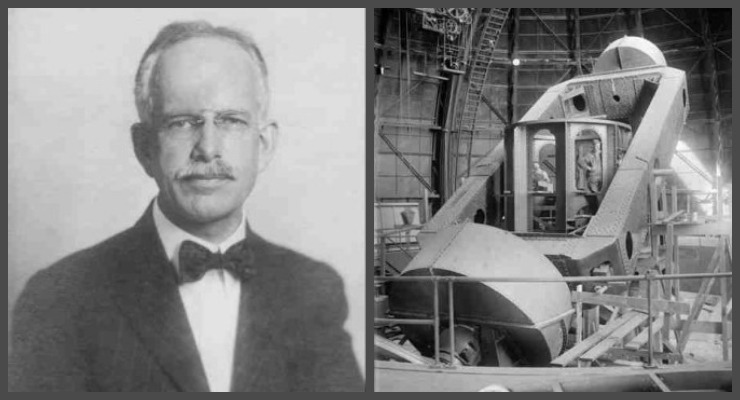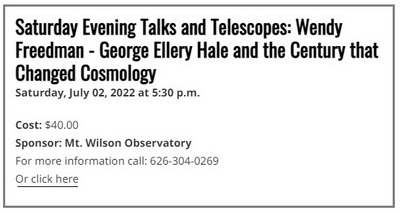
George Ellery Hale, June 29, 1868 – February 21, 1938 [Credit: Courtesy of Caltech Archives] At right, workers begin to install the 100-inch telescope tube at Mount Wilson. [Credit: Carnegie/ Huntington Library]
That might sound like more than a lifetime of accomplishments for one person, but Hale’s vision was also responsible for helping transform a small Pasadena vocational school called Throop University—founded in 1891—into Caltech, one of the top science and engineering universities in the world.
George Ellery Hale, an American astronomer who resided, worked and passed away in Pasadena and is known for building massive telescopes, made a lasting impact on astronomy and the overall growth of science and scientific institutions in the twentieth century. He is also known for inventing spectroheliograph, and discovering magnetic fields in sunspots.
“George Ellery Hale probably single-handedly had the most impact in his early 20th century astronomy in fact, leading up to the current century,” said Wendy Freedman, professor of astronomy and astrophysics at the University of Chicago, ahead to her talk Saturday on Hale.
“He was a unique individual who was accomplishing a great deal. And it was because of his technical capability and his science acumen and his leadership abilities that he’s had this remarkable influence,” said Freedman.
 For Freedman, among Hale’s major contributions in astronomy are his creation of a 60-inch telescope, the largest telescope in the world when it was completed in 1908, and the 100-inch Hooker telescope, completed in 1917. Both telescopes could be found at the Mount Wilson Observatory.
For Freedman, among Hale’s major contributions in astronomy are his creation of a 60-inch telescope, the largest telescope in the world when it was completed in 1908, and the 100-inch Hooker telescope, completed in 1917. Both telescopes could be found at the Mount Wilson Observatory.
“George Ellery Hale played a huge role himself, mostly in bringing in people who were extremely technically capable to build these telescopes. So he was very hands-on, but an incredible leader in terms of even before the 60 inch telescope had been finished, he was already making plans for the hundred inch telescope.”
The 60-inch telescope, capable of providing different optical configurations for a variety of uses, is one of the most productive telescopes in the history of astronomy, having been used largely for pioneering studies of the spectral classification of stars that are the basis of much of modern-day astronomy while the 100-inch Hooker telescope is best known for being the first to see beyond our Milky Way galaxy.
“Edwin Hubble, who began to use a hundred inch telescope, discovered that our Milky Way galaxy is only one of about a hundred billion galaxies in the observable universe. And then he went on to discover that, in fact, it appears that all galaxies are moving away from us,” said Freedman.
Calling the two telescopes marvels of technology, Freedman said Hale’s pioneering work includes instrumentation that allowed the discovery of magnetic fields on the sun.
“I’d say particularly the telescopes are marvels of technology and the hundred inch telescope, if you see it up close, it looks like a battleship and yet it is precisely balanced so that you can point it anywhere in the sky to look at objects in the sky. For example, George Ellery Hale developed instrumentation that allowed the discovery of magnetic fields on the sun located in the sun spots that we can see on the face of the sun. And so he had quite clever instrumentation that allowed him to do that for the first time,” Freedman said.
The 100-inch telescope was the largest optical telescope until 1948 when Hale completed the 200-inch Hale Telescope which can now be seen at Palomar Observatory in San Diego County.
On Saturday, July 2, at 5:30 p.m. Freedman, who is also a former director of the Carnegie Observatories in Pasadena, will talk about the revolutionary impact of Hale’s discoveries in the understanding of the universe.
Freedman’s research interests are in observational cosmology, measuring the expansion rate of the Universe, with current projects involving measurements of the Hubble constant. She will describe recent advances in the field, and a new generation of telescopes including the recently launched James Webb Space Telescope and the Giant Magellan Telescope, which will be constructed in the Andes Mountains in Chile, according to Mount Wilson Observatory’s website.
After the talk, guests can view the night sky until 11:30 p.m. through the Observatory’s 60-inch or 100-inch telescopes.
Additional telescopes will be set-up around the ground for viewing of different night sky objects, by the Los Angeles Astronomical Society.
To get tickets, visit: https://mtwilson.app.neoncrm.com/np/clients/mtwilson/event.jsp?event=16339&





